#ordinal numbers in english
Text
youtube
Learn Ordinal Numbers 1 to 100: Fun & Easy Guide for Hindi and Urdu Speaker | Udable
#ordinal number#ordinal numbers#learn ordinal numbers#ordinal numbers for kids#how to read 100 in ordinal number#ordinal numbers 1 to 10#ordinal numbers from 1 to 10#meaning of ordinal number#ordinal numbers in english#ordinal numbers 1-10#ordinal numbers 1 to 20#ordinal numbers 1 to 100#ordinal numbers 1 to 50#ordinal numbers 1-100#ordinal number kya hota hai#ordinal numbers kya hote hain#ordinal numbers meaning in hindi#ordinal number meaning#Youtube
0 notes
Text
In 1931, a scholar named Bernhard Bischoff decoded a cypher placed between two saints’ lives in an early ninth-century manuscript from Eichstätt, Germany. The lives were written about Saints Willibald and Winnebald, two English brothers who in the eighth century became, respectively, the Bishop of Eichstätt and Abbott of Heidenheim, both in the modern day region of Bavaria.
The cypher reads:

Secundumgquartum quintumnprimum sprimumxquartumntertium cprimum nquartummtertiumnsecundum hquintumgsecundum bquintumrc quartumrdinando hsecundumc scrtertium bsecundumbprimumm
Bischoff worked out that all vowels had been replaced by ordinal numbers - ‘second, g, fourth, fifth, n, first, s…’ and so on. Each of these numbers could be replaced with the corresponding vowel, to make the Latin sentence:
Ego una Saxonica nomine Hugeburc ordinando hec scribebam
I, a Saxon nun called Hugeburc, have written this
...
Hugeburc is the earliest known English woman author of a full-text literary work.
626 notes
·
View notes
Text

Derek Burrell-Davis - memo to BBC (May 67): “I had a satisfactory two-hour meeting with all four members of the Beatles Group this evening…..I don’t think it is over-stating it to say that they are enthusiastic about their participation in the ‘Our World’ programme and fully aware of the responsibilities they carry. Their approach is extremely professional and they are in complete agreement with the basic idea, which is that they are undertaking a recording session in the Number One Studio at E.M.I., Abbey Road. They cannot yet forecast what they will be doing in any great detail, but they propose writing a new number. Since this number will be heard in 30 countries, they are going to write the lyric in basic English. They suggest that they should use such words as “Hello, love, you, me, us, them, together, we”. They are wondering if it might be possible to use some of those words in different languages and are receptive to the idea that words such as “love”, “together”, etc. might be shown on large cards at appropriate moments in several languages”.

The BBC/broadcasters briefing meeting on 4 June 1967 to co-ordinate the international co-operation for the Our World Broadcast
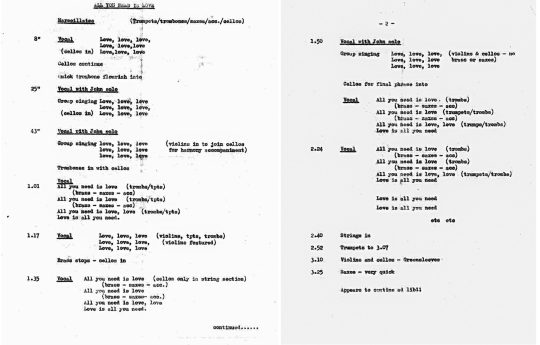
The lyrics sheet given to the cameramen before broadcast. They were not impressed. On being told the Beatles wrote the music, they only asked "did they write the words as well?"

“...the day before, the doors were thrown open for a free-for-all picture session, at which I managed to have a quick word with —
PAUL: Someone’s just asked if I’m leaving the group. And there seems to be another rumour I’m moving. Both are very wrong. I’ve just finished my house and like it a lot. No, I haven’t bought a kilt yet.
GEORGE: We will do a TV show before we do a film. Nothing new to tell you about the film project. No script yet.
RINGO: My garden is looking great now. Got some of my building men to help the gardening contractor and everything’s okay.
JOHN: This song will be our next single. This TV show will give it a nice send-off.
Indeed, with some 6,500 TV workers and 1,000,000 miles of telephone wire working for the disc, it couldn’t be bad!” - - Andy Gray, NME

“When the musicians and TV crew took a meal break the Beatles tried out the musical instruments left lying around [...] Ringo and George try the trumpets, whilst Paul has a go at the trombone and John plays Jack Emblow’s accordion. In the background, in the left side far corner, the large weight box on the back of the Mole Crane is visible, with one of the white painted Murphy TV monitors on its trolley over on the right of the picture.” - - David Taylor, Postfade


“The BBC want a live trail”, Derek told me suddenly over my intercom. No one knew this had been planned, in fact to this day few people seem to know that such a promotion ever took place. [...]
“I had a few words with each of them in turn. What was the song called? Whose idea had it been? (“His”, they said, pointing to each other). And then I put the question to John that was intriguing me. Ninety-five percent of all popular music is in 4-time, but there was more than a hint of unfamiliar 7-time in “All You Need ls Love“.
“Did you know your song was in 7-time?” I asked.
I still remember the cool, serious look he gave me as he replied, “Yes, I know”.
Then he indicated Paul, adding “- but blame him”.
“Paul himself, alert as ever, noticed how, against my own instincts, I was trying to inject some breezy gaiety into the proceedings. He spoke encouragingly in my ear. “Yock it up, Steve ! ” he said. He knew that it was my preference to be in the narrator’s box doing a technical job, rather than “yocking it up”. I duly yocked.”

“This was the biggest group in the world, but when they went to the canteen, it was just four guys having a cup of tea. Underneath it all, these were ordinary guys who were in a band.” - - David Magnus (photographer)

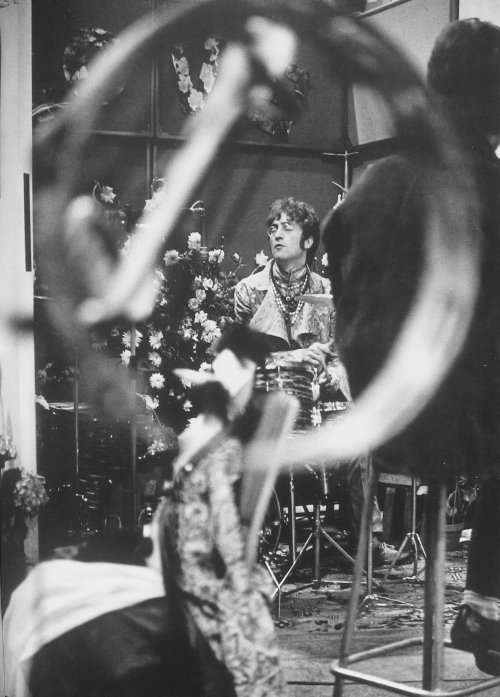

“There was a real party atmosphere, similar to what we had witnessed during previous real ‘happenings’, but Richard and I were struck by how visibly nervous John was, which was quite unusual for him: we’d never seen him wound up so tightly.” - - Geoff Emerick
“I did sense that John in particular felt rather apprehensive the nearer to transmission we got. However George seemed to be enjoying the moment, while Ringo and Paul showed no apprehension whatsoever.” - - David Magnus
______________________________
Almost this entire post is stolen from postfade.co.uk, written by David Taylor. It's a wonderful write up because it's only actually interested in the cameras used and the technical setup, but it's so interested in those that it covers every moment in glorious detail and pulls together lots of quotes. If you're interested in the ins and outs of outside broadcasting, oh my. There's a cut out diagram of the OB scanner van, and they've taken the video of the entire broadcast and marked up up to show the different camera shots and cuts and equipment used. There's a bit where they read in a book that some of the broadcast wasn't live, and so the author tracks down who wrote that and he says he copied it from Mark Lewisohn, so they track down ML and ask him why he wrote that and ML can't remember but says 'I wouldn't have written it down if there wasn't evidence for it', which they think is a bit weak, so they decide not to believe it. It's nice to see them belittling ML's lifework because they want to believe in the magic of live outside broadcasting, the same way we do when we want to believe in love.
#long post#sorry I guess#beatles day#all you need is love#love love#I love how much the cameramen were given that lyric sheet#and were just like what the fuck even is this????#<333333#the beatles#john lennon#[]
144 notes
·
View notes
Note
I know there are only two contractions in Spanish but what about contracted abbreviations, words you wouldn't pronounce contracted but would write them that way? For example, "cont'd" for "continued"?
There are plenty of abbreviations in Spanish like BBAA (bellas artes = fine arts), or RRHH (recursos humanos = human resources/HR)
Others are like etc for etcétera, vs for versus
Or PD which is PS in letters - literally posdata or postdata for "postscript"
Some that I've seen are like núm. for número, pág. for página, vol. for volumen or p. ej. as por ejemplo
You may also see dcho/a for derecho/a "right", and izq. / izdo/a / izqdo/a for izquierdo/a for "left"
Two others to know:
a.e.c -> antes de la era común = "BCE" or "before the common era" or BC
e.c. -> era común = "common era" or "AD"
Really common are the abbreviations for ordinal numbers
1er -> primer = first
1ero/a -> primero/a = first
2do/a -> segundo/a = second
3er -> tercer = third
3ero/a -> tercero/a = third
4to/a -> cuarto/a = fourth
5to/a -> quinto/a = fifth
6to/a -> sexto/a = sixth
7mo/a -> séptimo/a = seventh
8vo/a -> octavo/a = eighth
9no/a -> noveno/a = ninth
10mo -> décimo/a = tenth
These are the equivalents of using 1st, 2nd, 3rd etc. in English. You'll also sometimes see symbols that are like a tiny floating O or A to depict gender, they'll look sort of like the symbol for degrees
Most commonly it's for terms of address like Vd. / vmd = Vuestra Merced [Your Worship/Lordship/Ladyship], though this is older Spanish
Ud. = Usted
Uds. = Ustedes
D. = Don = "Mr."
Dña. = Doña = Mrs.
Sr. = Señor = Mr.
Sra. = Señora = Mrs. / Ma'am
Srta. = Señorita = Miss
Dr. = Doctor
Dra. = Doctora = [female] Doctor
And you get some that are abbreviations that can become their own words like las mates is short for las matemáticas so las mates is "math" rather than "mathematics"... or profe is a common way to address teachers in a friendly way like "teach"
Other common ones you might see are the ones for countries like EEUU is los Estados Unidos or "United States", or sometimes la RD for la República Dominicana for "Dominican Republic" or P. Rico is Puerto Rico but there are lots of country abbreviations especially for mailing purposes
This is also not talking about terms of address for military
Abreviaturas | Diccionario panhispánico de dudas (rae.es)
88 notes
·
View notes
Text
Numbers
What's 6 in Mando'a? What about 501st? How do you say "execute order 66"? In this blog post, we'll cover the Mando'a cardinal and ordinal number system, how to make any number from 0-9,999 and other words useful when discussing number and math. Sources are indicated with symbols (^ *) and listed at the bottom.
Numerals
Mando'a uses a base-5 numbering system supplemented with base-10 suffixes. This means 1-5 are unique words along with 0, 10, 100, and 1000. All other numbers are a combination of those words. As it stands, KT Mando’a allows us to count up to 9,999. Here are the counting numbers:
0 - naas^ (literally "nothing")
1 - solus (prefix: sol)
2 - t'ad (prefix: ad)
3 - ehn (prefix: ehn)
4 - cuir (prefix: cur)
5 - rayshe'a (prefix: she)
6 - resol (prefix: rol)
7 - e'tad (prefix: tad)
8 - she'ehn (prefix: shen)
9 - she'cu (prefix: shek)
For the tens place numerals (20, 30, 40, etc), add the “tens” suffix -’eta to the prefixes above above. 0 and 1 do not act as prefixes for counting purposes. 10 is a unique number (ta+raysh aka "two fives").
10 - ta'raysh
20 - ad'eta*
30 - ehn'eta*
40 - cur'eta*
50 - she'eta*
60 - rol'eta*
70 - tad'eta*
80 - shehn'eta*
90 - shek'eta*
For the hundreds place numerals, the principle is the same. Add the “hundreds” suffix -’olan to the original numbers. Like 10, 100 is a unique number.
100 - olan*
200 - ad'olan^
300 - ehn'olan^
400 - cur'olan^
500 - raysh'olan*
600 - rol'olan^
700 - tad'olan^
800 - shen'olan^
900 - shek'olan^
For the thousands place numerals, the pattern continues. The suffix for “thousands” is a conjunction between the suffixes for “ten” and “hundreds”, -’eta’olan. This makes it literally “tens of hundred”. 1000 is an exception to the rule and is instead “ten hundred”.
1000 - ta’raysh’olan*
2000 - ad’eta’olan^
3000 - ehn’eta’olan^
4000 - cur’eta’olan^
5000 - she’eta’olan*
6000 - rol’eta’olan^
7000 - tad’eta’olan^
8000 - shen’eta’olan^
9000 - shek’eta’olan^
More Numbers
To fill the gaps in the above list, simply write out each place with a space between. Eleven (11) is ta'raysh solus*. Two hundred-sixty-three (263) in English is ad’olan rol’eta ehn^ in Mando’a. "Execute order sixty-six" becomes "Ke narir haar’ke’gyce rol’eta resol".
Ordinals
To turn a numeral into an ordinal (1 to 1st or 10 to 10th), add the descriptor suffix -yc. Theoretically this should also work with the suffix -la, but -yc is the one explicitly acknowledged in the KT dictionary. The last (singles) place numeral receives the descriptor suffix. E.g. she’olan sol'yc (501st) or cur’etayc (40th)
Other Useful Words
Soletar, verb, "to count"
Sosol ti, phrase, "equal to"
Majycir, verb, "to add"
Te'habir, verb "to remove or take out" aka subtract
There's no ready answer for "multiply" or "divide", though creative use of tatugir "to repeat" could work in some cases. Fractions might be verbally represented as solus be ta'raysh "1 of 10" or some other prepositional combo that can also represent division. "Mathematics" also doesn't have a dedicated word, but "to calculate" is mirdir.
"But do Mandalorian space-barbarians really need to know math--"
Yes. Ballistics. Logistics. Counting pay. Math is everywhere, it is inescapable. Inevitable. Evil Essential.
Sources
Words without source symbols are from officially published works by Karen Traviss, namely the Republic Commando novels. Reference this index to see the book & page number.
Asterik* words are from the lexicon Karen Traviss published digitally, which is hosted as-is on Mandoa.org without alterations (or corrections).
Carat^ words are derivations from the canon words' established patterns. As such, if you want to go with a different interpretation, have fun! These are suggestions and I ain't a cop. We'll answer follow-up questions on how they're derived, but we're not interested in arguing merits of one interpretation over another.
#mando'a#mandoa#conlang#star wars#mandalorians#numbers#counting#fucking MATH can't believe yall brought me outta retirement for MATH#language#linguistics#the mandalorian#legends canon#extended universe canon
183 notes
·
View notes
Note
Hello! I love your blog! I wanted to ask, I'm writing a fictional DnD setting in which a culture based on the Sumerians refer to their Rite of Passage as the "Journey to the Underworld." They go through this twice times in their lives, once when they come of age, and then for their funeral rites. As far as my uneducated self can get is "Kaskal-Kur" So I wanted to ask, how can you say "First Journey to the Underworld" and "Second Journey to the Underworld." Thank you so much!!!
Hello, and thanks for the kind words!
You're on the right track. Kaskal 𒆜 is "way, journey, caravan" and kur 𒆳 is "underworld" (as well as "mountain"), and these two words appear in the opening lines of Inanna's Descent, the primary story of such a journey in Sumerian literature. To put them together into "journey to the underworld", we'd have to put kur in the terminative case, equivalent to "to, towards, into" in English - so the phrase would be kaskal kurshe 𒆜 𒆳𒂠.
Here's where we run into a tricky spot. In English, cardinal numbers (one, two, three...) and ordinal numbers (first, second, third...) are very different. But in Sumerian, they generally look identical - the counting number for "one" and the word for "first" are both dish 𒁹. (Some theorize that they were pronounced differently, but they were always written identically so our best guess is that they were the same.) "Two" and "second" are both min(a) 𒈫.
So the basic way to translate the phrases would be kaskaldish kurshe 𒆜𒁹 𒆳𒂠 and kaskalmin kurshe 𒆜𒈫 𒆳𒂠, sort of like saying "Journey #1 to the Underworld" and "Journey #2 to the Underworld". I hope that's helpful, and best of luck with your writing!
35 notes
·
View notes
Text

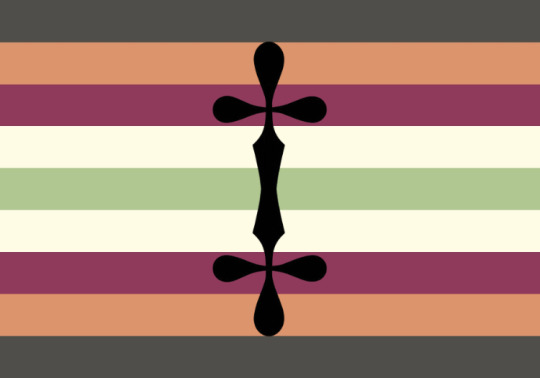

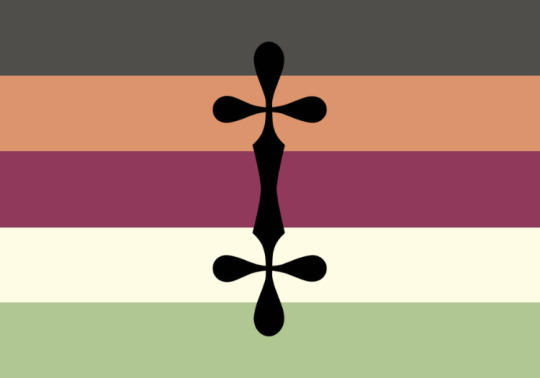
[Image ID: Four images of the Erenth pride flag, created by Gent (Gender-Jargon). Image 1) is the nine-stripe flag. This flag has nine horizontal stripes of the same size. From top to bottom, the stripes are dark grey, peach, dark red, cream, desaturated light green, cream, dark red, peach and dark grey. Image 2) is the same nine-stripe flag, but with a centered, black double dagger obelus mark. Image 3) is the five-stripe simplified design. The simplified flag has five horizontal stripes of the same size. From top to bottom, the stripes are dark grey, peach, dark red, cream and desaturated light green. Image 4) is the same simplified flag, but with a centered, black double dagger obelus mark. ./. END ID]
Erenth: a term describing one who does not participate in the concept of gender, instead embracing the self-hood that proceeds the construct unencumbered.
[PT: Erenth: a term describing one who does not participate in the concept of gender, instead embracing the self-hood that proceeds the construct unencumbered. ./. END PT]
Etymology
[PT: Etymology ./. END PT]
"Ere", from Early Modern English, meaning "Before" + "-nth" from English, meaning "an unspecified/indefinitely large ordinal number".
Here, "before" refers to the intrinsic self that exists free of gender, a state that has not yet been evaluated or considered within the construct. "Ere" was chosen to represent existing outside the gender paradigm, much like "Ere" belongs to an earlier stage English. "Nth" is used as a suffix, but it refers to the infinitely large, variable, complex, convoluted, nebulous nature of gender identity.
Erenth was coined by Gent (Gender-Jargon) in April 2024.
Elaboration
[PT: Elaboration ./. END PT]
Erenth is not a gender identity, but rather a label used to describe individuals whose selfhood does not involve the construct of gender, identifying with a personal, individual albeit degendered selfhood instead. As such, an Erenth:
Does not have a gender identity in any way, shape or form.
Doesn't align themselves with any gender (unaligned).
Does not have a gender identity to conform to, bend or subvert.
May embody gendered roles without consideration to the concept of gender or may reject them all together.
Does not have a gender to express, thus lacking a gender expression.
Presents themselves without consideration to the concept of gender, instead seeking to make their presentation harmonious and congruent with their sense of self.
Uses (self-)referential language without consideration to the concept of gender, using whatever language they see fit.
In lacking a gender identity, likely do not self-describe using GLG orientations.
May have an internalized self-concept of sex that is degendered or may reject sex altogether.
May reject, eschew, subvert, ignore, transcend, be liberated from, be apathetic towards, be oblivious to or hold any stance, perspective or experience regarding the concept of gender that results in non-participation in the construct.
May or may not identify as Queer.
Is simply themselves, embodying the answer to the question, "Who Am I?" while also discarding the construct of gender entirely from the question.
[PT: Does not have a gender identity in any way, shape or form. Doesn't align themselves with any gender (unaligned). Does not have a gender identity to conform to, bend or subvert. May embody gendered roles without consideration to the concept of gender or may reject them all together. Does not have a gender to express, thus lacking a gender expression. Presents themselves without consideration to the concept of gender, instead seeking to make their presentation harmonious and congruent with their sense of self. Uses (self-)referential language without consideration to the concept of gender, using whatever language they see fit. In lacking a gender identity, likely do not self-describe using GLG orientations. May have an internalized self-concept of sex that is degendered or may reject sex altogether. May reject, eschew, subvert, ignore, transcend, be liberated from, be apathetic towards, be oblivious to or hold any stance, perspective or experience regarding the concept of gender that results in non-participation in the construct. May or may not identify as Queer. Is simply themselves, embodying the answer to the question, "Who Am I?" while also discarding the construct of gender entirely from the question. ./. END PT]
Some similar labels include:
Egogender
[PT: Egogender ./. END PT]
Both Egogender and Erenth individuals identify with an unique and individualistic sense of self, but differ in that the Erenth label is not a gender and does not participate in the construct.
Exogender
[PT: Exogender ./. END PT]
Both Exogender and Erenth individuals do not participate in the construct of gender, thus lacking a gender identity, but differ in that the Erenth label specifies an unique, individual sense of self one embraces entirely independent of the construct of gender identity. Exogender, while not truly being a gender identity by it's definition, attempts to fill the lexical gap by relating to the construct, where the Erenth label does not participate in it explicitly and outright.
Apogender
[PT: Apogender. ./. END PT]
Both Apogender and the Erenth label involve being divorced from the concept of gender, but differ in that Apogender is an Agender microlabel, whereas Erenth is not a gender identity and involves embracing the self.
Pomogender
[PT: Pomogender ./. END PT]
Both Pomogender and the Erenth label involve denying preexisting gender labels, but differ in that Erenth is not a gender identity, denies the entirety of the construct of gender and embraces a unique, individual sense of self outside of gender.
Cassgender
[PT: Cassgender ./. END PT]
Both Cassgender and the Erenth label may involve feeling indifferent towards the concept of gender, but differ in that Cassgender is a gender identity whereas the Erenth is not a gender identity, does not participate in the construct and specifically involves embracing a unique, individual sense of self outside of gender.
Yonderi
[PT: Yonderi ./. END PT]
Both Yonderi and Erenth are labels describing transcending gender, but differ in that the Erenth label also does not participate in or internalize the construct while also specifically embracing a unique, individual sense of self outside of gender. Erenth can be considered to have a yonderine quality, but doesn't have to.
Genderfree
[PT: Genderfree ./. END PT]
Both Genderfree and the Erenth label both refer to an undefined state where gender is not present, but unlike Genderfree, Erenth rejects the construct of gender in it's entirety, is not an ambiguous identity nor is it definitively queer in itself. Furthermore, an Erenth individual's identity is related to their sense of self, which is not specified by the label genderfree.
Pride Flag
[PT: Pride Flag ./. END PT]
The flag was created by myself (Gent, GJ) at the same time as the term. The flag has nine horizontal stripes of the same size. From top to bottom, the stripes are dark grey, peach, dark red, cream, desaturated light green, cream, dark red, peach and dark grey. The stripes have the following meanings:
The bottom and top dark grey stripes represent the lack of internalization of gender.
The two peach stripes represents complete non-participation in the construct of gender.
The two dark red stripes represents knowledge and conviction.
The two cream stripes represent one's values and ideals.
The middle desaturated light green stripe represents one's inner sense of self.
[PT: The bottom and top dark grey stripes represent the lack of internalization of gender.The two peach stripes represents complete non-participation in the construct of gender. The two dark red stripes represents knowledge and conviction.The two cream stripes represent one's values and ideals. The middle desaturated light green stripe represents one's inner sense of self. ./. END PT]
I also created a simplified, five-stripe version using the same colors and meaning as the nine-stripe flag. The simplified flag has five horizontal stripes of the same size. From top to bottom, they are dark grey, peach, dark red, cream and desaturated light green.
Glyph
[PT: Glyph ./. END PT]
As Erenth is not a gender, it does not have a planetary glyph associated with it. Instead, the Erenth identity is represented by the typographical obelus, styled as a double dagger mark, U+2021 (‡). The obelus represents, "an iron roasting spit, a dart, or the sharp end of a javelin, symbolizing the skewering or cutting out of dubious matter. (Wikipedia)", which is similar to the manner in which an Erenth individual embraces their selfhood (separated from gender), but not the construct of gender (the dubious matter). The double dagger mark was specified to represent a coupled rejection of gender and acceptance of the self.
#Erenth#mogai#microlabel#term#not gender#autonomous#egogender#exogender#apogender#pomogender#cassgender#yonderi#yonderine#genderfree#the self#identity#personal identity#pride flag#mogai gender#mogaireal#mogai safe#mogai positive#pro mogai#mogai friendly#mogai coining#liomogai#liom#nonbinary#anonbinary#trans
22 notes
·
View notes
Note
Hi! I'm new on Tumblr so sorry if I trapass any line asking this.😅
Recently I read an immagine about our Batchers and their numbers and I noticed that they're a squad no? But normal clone squads are composed by 5 clones not 4.
And then I realised that 99 is the number of the clone force. What if the missing clone from the Bad Batch was in fact clone 99? And something happened in his gene modification and he turned out like that.
(I know it's long but I need a lot of word to express myself. Also English isn't my first language so sorry if there are any mistakes. Love your work btw☺️)
Hi there! Welcome ~
So, as far as I understand, Commando squads, such as the batch, are generally made up of four men.
For example, Delta Squad. Which is made up of Boss, Fixer, Scorch, and Sev.
The Batch follows a similar makes with Hunter, Tech, Wrecker, and Crosshair. With the same specialties.
Hunter/Boss being the squad leader. Tech/Fixer being the tech expert. Wrecker/Scorch being explosive ordinances expert. Crosshair/Sev being snipers.
Regular squads, such as Domino Squad, are set up a bit differently, being made up of five parts rather than four. Why this is, I have no idea. I can hazard a guess, based off of what I remember if their personalities, that the squads would have the same basic make-up as delta, but with an additional "face" person. You know, the charming one who is naturally good at dealing with civilian.
Of course. I could just be pulling this out my ass. It's entirely possible that squads are always made up of four men and domino squad is just weird.
As for 99...if I remember correctly, his proper designation is Alpha-99, which would put him in the same area as Alpha-17. If I remember correctly there was a problem with the increased aging gene with 99 so he aged a lot faster than his brothers and the Kaminoans didn't bother to try and fix it.
Although, perhaps 99 was meant to be their trainer? Which would explain why they have designations CT-9901 to CT-9904.
But really, this is just me rambling at this point. Train of thought writing, ftw lol.
And no need to worry about the language thing! You probably speak English better than I do and I'm a native speaker!
18 notes
·
View notes
Text
Political gains & contents of the Concordat of 1801

Agreement between Napoleon Bonaparte and Pope Pius VII on 15 July 1801 in Paris.
Rome seems to have made immense sacrifices. The first advantage won by the First Consul was to seal, by the very act of signing an agreement, the recognition of the French Republic by the Holy See, and hence the rupture of the traditional alliance between Rome and the legitimate monarchies. It was a disastrous blow to French royalism in exile, for it freed the faithful in the interior from scruples about the regime of the Year VIII.
The second advantage was to confirm a church of salaried public servants, amenable to the State and having mainly sociological functions. Here we see a continuation of the Gallican tradition, but also of the thought of philosophes who had urged both the submission of the clergy to the State and its integration within it. The refusal to reestablish the religious orders meant also the rejection of any ecclesiastical life that might escape the authority of the bishops. Even the cathedral chapters were reduced to decorative functions.
Thirdly, no question was raised about the sale of the former Church properties, a matter of great importance for strengthening the prestige of Bonaparte in the eyes of the property-owning segments of French society.
Pius VII, for his part, failed to obtain the recognition of Catholicism as the state religion. He agreed to use his authority for what Consalvi called “the massacre of a whole episcopate,” by requiring the resignation of all French bishops, both constitutional and refractory, since Napoleon judged such a step to be indispensable for effacing all traces of the revolutionary schism. It is right to see in this operation an encouragement to ultramontanism, for it affirmed the powers of the Pope over the French Church. But it also encouraged a tendency in the French episcopate, that is, a whole ecclesiological movement for appeal to an ecumenical council in matters of discipline.
Among the numerous provisions of the Articles we may point out those that legalized all forms of worship in France, and those that strictly subordinated the lower clergy to the bishops (“prefects in violet robes”): only a fifth of the parish priests received the title of curé, and with it secure tenure; all others became simple desservants of succursales, that is assistant pastors.
This is what the Church got out of the deal:
What then did the Pope gain in this Concordat, “more likely to raise difficulties than to solve them” (Bernard Plongeron). Maintenance of the unity of the Roman Church, which a consolidation of the schism in France might have ruined forever; recognition of canonical investiture, which allowed the Pope to overcome the zelanti among the cardinals who opposed the Concordat but favored a reinforcement of spiritual authority; and resumption of regular pastoral life in France, where the new administrative and social status of the priest encouraged a growing number of ordinations, which reached several hundred by the end of the Empire.
Pius VII in any case remained attached to the results accomplished, a fact that deprived the small “shadow church” opposed to the Concordat of the possibility of resistance. His continuing attitude was shown later in his willingness to come to Paris for the Emperor’s coronation.
Source: Louis Bergeron, L'Episode napoléonien. Aspects, intérieurs: 1799-1815
English: France Under Napoleon, tr. R. R. Palmer
#Louis Bergeron#Bergeron#napoleon#napoleonic era#napoleonic#napoleon bonaparte#first french empire#french empire#L'Episode napoléonien. Aspects intérieurs: 1799-1815#France Under Napoleon#Napoleon’s reforms#reforms#Concordat#christianity#Christian#19th century#histriy#Catholic Church#Catholic#history#1800s#french revolution#Pope Pius VII#Pius VII#napoleonic reforms
29 notes
·
View notes
Text
[D]omesticated attack dogs [...] hunted those who defied the profitable Caribbean sugar regimes and North America’s later Cotton Kingdom, [...] enforced plantation regimens [...], and closed off fugitive landscapes with acute adaptability to the varied [...] terrains of sugar, cotton, coffee or tobacco plantations that they patrolled. [...] [I]n the Age of Revolutions the Cuban bloodhound spread across imperial boundaries to protect white power and suppress black ambitions in Haiti and Jamaica. [...] [Then] dog violence in the Caribbean spurred planters in the American South to import and breed slave dogs [...].
---
Spanish landowners often used dogs to execute indigenous labourers simply for disobedience. [...] Bartolomé de las Casas [...] documented attacks against Taino populations, telling of Spaniards who ‘hunted them with their hounds [...]. These dogs shed much human blood’. Many later abolitionists made comparisons with these brutal [Spanish] precedents to criticize canine violence against slaves on these same Caribbean islands. [...] Spanish officials in Santo Domingo were licensing packs of dogs to comb the forests for [...] fugitives [...]. Dogs in Panama, for instance, tracked, attacked, captured and publicly executed maroons. [...] In the 1650s [...] [o]ne [English] observer noted, ‘There is nothing in [Barbados] so useful as … Liam Hounds, to find out these Thieves’. The term ‘liam’ likely came from the French limier, meaning ‘bloodhound’. [...] In 1659 English planters in Jamaica ‘procured some blood-hounds, and hunted these blacks like wild-beasts’ [...]. By the mid eighteenth century, French planters in Martinique were also relying upon dogs to hunt fugitive slaves. [...] In French Saint-Domingue [Haiti] dogs were used against the maroon Macandal [...] and he was burned alive in 1758. [...]
Although slave hounds existed throughout the Caribbean, it was common knowledge that Cuba bred and trained the best attack dogs, and when insurrections began to challenge plantocratic interests across the Americas, two rival empires, Britain and France, begged Spain to sell these notorious Cuban bloodhounds to suppress black ambitions and protect shared white power. [...] [I]n the 1790s and early 1800s [...] [i]n the Age of Revolutions a new canine breed gained widespread popularity in suppressing black populations across the Caribbean and eventually North America. Slave hounds were usually descended from more typical mastiffs or bloodhounds [...].
---
Spanish and Cuban slave hunters not only bred the Cuban bloodhound, but were midwives to an era of international anti-black co-ordination as the breed’s reputation spread rapidly among enslavers during the seven decades between the beginning of the Haitian Revolution in 1791 and the conclusion of the American Civil War in 1865. [...]
Despite the legends of Spanish cruelty, British officials bought Cuban bloodhounds when unrest erupted in Jamaica in 1795 after learning that Spanish officials in Cuba had recently sent dogs to hunt runaways and the indigenous Miskitos in Central America. [...] The island’s governor, Balcarres, later wrote that ‘Soon after the maroon rebellion broke out’ he had sent representatives ‘to Cuba in order to procure a number of large dogs of the bloodhound breed which are used to hunt down runaway negroes’ [...]. In 1803, during the final independence struggle of the Haitian Revolution, Cuban breeders again sold hundreds of hounds to the French to aid their fight against the black revolutionaries. [...] In 1819 Henri Christophe, a later leader of Haiti, told Tsar Alexander that hounds were a hallmark of French cruelty. [...]
---
The most extensively documented deployment of slave hounds [...] occurred in the antebellum American South and built upon Caribbean foundations. [...] The use of dogs increased during that decade [1830s], especially with the Second Seminole War in Florida (1835–42). The first recorded sale of Cuban dogs into the United States came with this conflict, when the US military apparently purchased three such dogs for $151.72 each [...]. [F]ierce bloodhounds reputed to be from Cuba appeared in the Mississippi valley as early as 1841 [...].
The importation of these dogs changed the business of slave catching in the region, as their deployment and reputation grew rapidly throughout the 1840s and, as in Cuba, specialized dog handlers became professionalized. Newspapers advertised slave hunters who claimed to possess the ‘Finest dogs for catching negroes’ [...]. [S]lave hunting intensified [from the 1840s until the Civil War] [...]. Indeed, tactics in the American South closely mirrored those of their Cuban predecessors as local slave catchers became suppliers of biopower indispensable to slavery’s profitability. [...] [P]rice [...] was left largely to the discretion of slave hunters, who, ‘Charging by the day and mile [...] could earn what was for them a sizeable amount - ten to fifty dollars [...]'. William Craft added that the ‘business’ of slave catching was ‘openly carried on, assisted by advertisements’. [...] The Louisiana slave owner [B.B.] portrayed his own pursuits as if he were hunting wild game [...]. The relationship between trackers and slaves became intricately systematized [...]. The short-lived republic of Texas (1836–46) even enacted specific compensation and laws for slave trackers, provisions that persisted after annexation by the United States.
---
All text above by: Tyler D. Parry and Charlton W. Yingling. "Slave Hounds and Abolition in the Americas". Past & Present Volume 246, Issue 1, pages 69-108. February 2020. [Bold emphasis and some paragraph breaks/contractions added by me.]
#abolition#its first of february#while already extensive doumentation of dogs in american south in 1840s to 60s#a nice aspect of this article is focuses on two things#one being significance of shared crossborder collaboartion cooperation of the major empires and states#as in imperial divisions set aside by spain britain france and us and extent to which they#collectively helped each other crush black resistance#and then two the authors also focus on agency and significance of black resistance#not really reflected in these excerpts but article goes in depth on black collaboration#in newspapers and fugitive assistance and public discourse in mexico haiti us canada#good references to transcripts and articles at the time where exslaves and abolitionists#used the brutality of dog attacks to turn public perception in their favor#another thing is article includes direct quotes from government and colonial officials casually ordering attacks#which emphasizes clearly that they knew exactly what they were doing#ecology#indigenous#multispecies#borders#imperial#colonial#tidalectics#caribbean#carceral geography#archipelagic thinking
21 notes
·
View notes
Text
Today in Christian History

Today is Thursday, April 25th, 2024. It is the 116th day of the year in the Gregorian calendar; Because it is a leap year, 250 days remain until the end of the year.
62: Death of Mark the Gospel writer while imprisoned in Alexandria in the eighth year of Nero, according to Vetus martyrologium romanum (an old Roman collation of martyr accounts).
799: Pope Leo III is attacked, his eyes stabbed, and his tongue torn. He recovers and later crowns Charlemagne as emperor.
1449: The ineffectual Council of Basel ends.
1479: Death of Sylvester of Obnorsk, a Russian Orthodox hermit who had lived off roots and bark. Eventually he had established a monastery.
1564: John Calvin, reformer of Geneva, dictates his last will and testament to notary Peter Chenalat.
1595: Death from a fever in the convent of St. Onofrio of Italian poet Torquato Tasso. Ironically, he was supposed to receive a laurel from the pope on this day in recognition of his epic poems, among which Jerusalem Delivered had been the most acclaimed.
1735: Death at Epworth, England, of Samuel Wesley, curate, author, and father of Methodist revival leaders John and Charles Wesley.
1800: Death at East Dereham, Norfolk, England, of English poet William Cowper (pictured above). Despite lifelong depression, he had produced enduring hymns, including, “Oh For a Closer Walk with God” and “There is a Fountain Filled with Blood.” Dementia had led him to believe he was damned.
1879: Consecration of J. B. Lightfoot as Bishop of Durham. A renowned English New Testament scholar, he had left Cambridge and a life of scholarship to devote the remaining ten years of his life to church administration.
1889: Death at Mt. Pleasant, Michigan, of Anzentia Igene Perry Chapman. A member of the Free Methodist Church, she wrote a number of hymns, including, “Thou Shalt Rest at Eve,” and “We’ll Never Say Goodbye.”
1917: Ordination of Paul Sasaki as a priest in the Anglican Church in Japan. He will become bishop of Nippon Sei Ko Kei (an independent church organization within the Anglican Communion), and suffer imprisonment for his refusal to bring Nippon Sei Ko Kei under the authority of a government-ordered church coalition.
14 notes
·
View notes
Text
reading demon slayer: chapter 8 name breakdown
in this chapter, there are no names of people or places or weapons to go over. instead, we will be covering the demon slayer ranking system, which is introduced by kiriya (the black-haired twin at final selection). from highest to lowest, demon slayers are ranked as follows:
甲・乙・丙・丁・戊・己・庚・辛・壬・癸
which in english simply translates to first, second, third, fourth, fifth, sixth, seventh, eighth, ninth, and tenth in rank. the official english version chose to transliterate these names instead of translating them.
there is another layer to these names beyond their usage as ordinal numbers, however. the set of characters used here are a part of the traditional chinese calendar system known as the heavenly stems. the heavenly stems are used in combination with the earthly branches, an ordering system related to the chinese zodiac, to form a 60-year calendar cycle.
you might protest that there are 10 stems and 12 zodiac signs, which multiplies to 120, not 60. it's better to think of the stems as 5 pairs (you'll see why below), and 5 times 12 is indeed 60.
so what do the stems represent? well, each stem has its own alignment to a few basic concepts of traditional chinese philosophy--yin and yang, the five elements*, and the cardinal directions. the five elements are wood, fire, earth, metal, and water. each element is associated with a cardinal direction--wood is east, fire is south, earth is middle, metal is west, and water is north. here's how it all works out:
甲 (きのえ) - yang, wood, east
乙 (きのと) - yin, wood, east
丙 (ひのえ) - yang, fire, south
丁 (ひのと) - yin, fire, south
戊 (つちのえ) - yang, earth, middle
己 (つちのと) - yin, earth, middle
庚 (かのえ) - yang, metal, west
辛 (かのと) - yin, metal, west
壬 (みずのえ) - yang, water, north
癸 (みずのと) - yin, water, north
as you can see, the stems are 5 yin-yang pairs, one for each of the five elements/cardinal directions. this is where the names for the stems in japanese come from, and these are the names you're probably familiar with from reading or watching demon slayer in english. the first part of the name is the native japanese pronunciation for the associated element: き, like 木, for wood; ひ, like 火, for fire; つち, like 土, for earth; か, like 金, for metal; and みず, like 水, for water. next is の, which connects the first part to the last, and the last part is either え or と--え like in 上, meaning older, and と like in 弟 or 乙, meaning younger.
like i said earlier, these names really have no bearing on how they're used in demon slayer (i.e. as ordinal numbers). the demon slayer ranks are straightforwardly named first through tenth. the heavenly stem names and meanings do not need to be taken into account at all. i just thought it was something interesting to talk about :)
that's all i have for this chapter's name breakdown. it's a bit of a long one, so thank you very much to anyone who read this far! if you're interested in chinese philosophy or astrology, i recommend doing that research on your own, because i'm already a bit out of my depth just summarizing the basics. thanks again for reading, and please look forward to the next posts! 読んでくれてありがとう!次の投稿を楽しみにしてください!
*"five elements" is a bit of a misnomer, since they're not really equivalent to the four elements of western philosophy. it's the most well-known term for them, though, so that's what i went with.
13 notes
·
View notes
Text
Looking for a word
"Cardinal" numbers tell how many. (one, two, three apples)
"Ordinal" numbers tell what order. (first, second third apple)
There are a few words that tell "how many times". As far as I can find, there are only three in English: once, twice, and thrice. This is number as an adverb, but I can't find a name for it.
4 notes
·
View notes
Note
do you know of any adjective order rules in spanish? not necessarily rules as in "anything else is wrong", but in "anything else sounds weird"
(like in english, where "brown big bear" isn't technically wrong, just... weird)
Okay FYI I ramble a lot in this, and I tried to make it clearer in places but just know that this is a lot of stuff, and I repeat myself, and though there are some rules, sometimes it's about feeling and what sounds right rather than a regular rule
Regardless of whether the adjectives go in front or in back, just know that Spanish (and English) tends to put adjectives of opinion, size, origin/nationality, color, and quality as the most important
Other adjectives like determiners take precedence always
And other adjectives are stuck to the noun as a collocation. More below.
-
There are four things I just need to say first and then we'll really get into it:
For your basic average garden variety adjectives, they typically go behind the noun like la flor hermosa "beautiful flower". If you put them in front, you're sounding extra super fancy poetic lyrical so do this sparingly or for Dramatic Flair; la hermosa flor "the beautiful flower" sounds like I'm reading poetry
There are some adjectives that change meaning depending on placement - prime example is mismo/a, where you can say la misma cosa "the same thing" vs. la cosa misma "the thing itself", where mismo/a is related to "same" or "selfsame" [like el mismísimo rey "the king himself" or "the very king himself"]. Literally it is "selfsame"... in front "same", in back "self". Another one is antiguo/a which in front often means "ancient" or "antique" or "former", while in the back it can be "old" as in "old-fashioned" or "antiquated". And bueno/a and malo/a for "good" and "bad" will constantly confuse you too
There are certain adjectives that are what we call "determiners" that are almost always in front (except occasionally for dramatic effect). A determiner is usually a specific adjective like possessive adjectives, demonstratives, adjectives of quantity (mucho/a, poco/a), and question words just to name a few. Determiners are also the definite and indefinite articles - el, la, los, las and un, una, unos, unas, and also includes numbers both cardinal [one, two, three] and ordinal [first, second, third]
A very important thing to note about adjectives is a potential "collocation" - meaning a noun + adjective that work together as a sort of cohesive unit. An example las bellas artes is "fine arts", but literally "the beautiful arts" but written fancy-like because bello/a meaning "beautiful" would typically go behind. In this case, las bellas artes is almost like a separate piece of vocab because you can't really separate them. Another would be something like el oso pardo which is "brown bear" or "grizzly bear", the adjective pardo/a refers to a brownish coloring but in this case it is stuck to oso almost like it's a specific descriptor that makes it a full "unit". These are best learned like your normal vocab, or understood as compound nouns that you can't break up... things like el agua dulce "freshwater" [instead of salt water], la sal marina "sea salt", las malas hierbas "weeds", la luna llena "full moon", el águila calva "bald eagle", el pavo real "peacock", la caja fuerte "safe/lockbox" etc etc.
-
Essentially, the adjectives are free to move around, except for when they're not
When it's your regular adjectives, you're free to say them in any order you like - they're regular descriptions, and all you need to keep in mind is potentially when y turns to e / o turns to u, and little grammatical hiccups like that:
Su ascendencia es alemana, irlandesa, e italiana. = Their heritage is German, Irish, and Italian.
Su ascendencia es italiana, irlandesa, y alemana. = Their heritage is Italian, Irish, and German.
No difference though I would personally assume the first one you mention is maybe the most important or the largest part.
Same with general descriptions:
Es un edificio notable y llamativo. = It's a notable and eye-catching building.
Es un edificio llamativo y notable. = It's an eye-catching and notable building.
Es una mujer lista y trabajadora. = She's a smart and hard-working woman.
Es una mujer trabajadora y lista. = She's a hard-working and smart woman.
Where you get into iffy territory is when adjectives come in front
I personally would say if you're using bueno/a or malo/a in front of an adjective it's one that almost always goes first except if there's a determiner:
el buen hombre = the good man
un buen hombre = a good man
este buen hombre = this good man
la buena mujer = the good woman
una buena mujer = a good woman
esta buena mujer = this good woman
Same with other determiners like cualquier buen hombre "any good man", cada buen hombre "each good man", muchas buenas mujeres "many good women" etc.
This is also something to keep in mind with collocations and set phrases:
En el Antiguo Egipto, había dos reinos distintos - Alto Egipto y Bajo Egipto, y en las épocas posteriores se unificaron, y fueron gobernados por unos poderosos reyes-dioses conocidos como los faraones.
"In Ancient Egypt, there were two different kingdoms, Upper Egypt and Lower Egypt, and in later times they united and were governed by some powerful god-kings known as the pharaohs."
So let's examine that further:
Something like el Antiguo Egipto, el Alto Egipto, el Bajo Egipto or something like el Imperio Antiguo "the Old Kingdom" of Egypt are collocations, consider them their own vocab and try not to think too hard on it because sometimes they're just set phrases like la Antigua Grecia "Ancient Greece", Gran Bretaña "Great Britain", or el Sacro Imperio Romano "the Holy Roman Empire"
A word like poderoso/a sort of becomes a more intense verison of itself changing its normal location; if it were el rey poderoso you might translate that as "powerful king" or "strong king", putting el poderoso rey adds some oomph to it and now it's "the mighty king" as if that's the most important aspect of it and it's exceptional - and regular adjectives can follow normally; el poderoso rey conocido como "the mighty king known as"
-
I should also mention that there are adjectival phrases involving de, but you've probably seen them already... like... es un libro de literatura infantil "it's a children's literature book"
I think this is more specifically like "the genitive case", which is normally used linguistically to talk about possessives or qualifiers of some kind, but they are often attached directly to the noun and tend to preempt most adjectives:
El maravilloso mago de Oz es un libro de literatura infantil estadounidense muy popular. = The Wonderful Wizard of Oz is a very popular book of children's literature.
-
...Again, just some general notes because I feel like I was rambling a lot:
Adjectives sometimes go in front or behind the noun depending on their function in the sentence
Most adjectives end up behind the noun
Determiners pretty much always go in front 95% of the time
The articles - el/la/los/las or un/una, unos, unas are the first determiner adjectives 99.999% of the time; possessives can take the place of articles... el dinero "the money" vs. su dinero "their money"
Determiners of numbers (cardinal numbers or ordinal numbers) are almost always the second adjective mentioned, even if there are other determiners... el primer paso "the firststep", mi primer paso "my first step"
Adjectives like "good", "bad", "big", and a few others are often the next adjectives if there are other determiners... el primer gran paso "the first great step" or mi primer gran paso "my first great step"
As a quick example... las tres buenas hadas "the three good fairies"... 1st is las as the article, then tres is a cardinal number, and then you have the adjective of quality "good"
Some adjectives can change meaning depending on placement - las tres buenas hadas "the three good fairies" implies that "good" is their main quality, as opposed to evil. But if you said las tres hadas buenas it comes out as "the three nice fairies" as if you're talking about personality
Keep an eye out for certain collocations and set phrases that should be treated as separate vocab and not to be separated - esta noche "tonight", la prensa rosa "tabloids" [lit. "pink press"], or la montaña rusa "rollercoaster" [lit. "Russian mountain"]
Collocations or set adjectival phrases like de can't be broken up... la luna de hoy "today's moon" vs. la luna llena de hoy "today's full moon" / and la luna de esta noche "tonight's moon" or la luna llena de esta noche "tonight's full moon"
If you're adding nationalities, they tend to show up immediately after the noun or the first noun phrase since they qualify everything - la literatura infantil popular "popular children's literature" vs. la literatura infantil estadounidense popular "popular American children's literature" or la literatura infantil francesa "popular French children's literature"
If you're doing a list of regular adjectives, you can probably put them in any order you want
But be aware that some adjectives go in front more and some go in back more, and sometimes it's a matter of style - such as el famoso oso panda chino "the (very) famous panda bear from China"
Certain qualities like "big/small", nationality, "good/bad", "elder/younger" do take priority though; as an example mi heramana inteligente "my smart sister" vs. mi heramana menor inteligente "my smart younger sister" or mi hermana pequeña inteligente "my smart little sister"
Additionally:
Adverbs always go in front of the adjective they're modifying... la familia más conocida "the most well-known family", una historia muy larga "a very long story"
Possessives in their more adjectival form ALWAYS go after the noun... su libro "their book" vs. el libro suyo "the book of theirs"; this is part of the genitive/possessives but possessives
Don't separate collocations or set phrases or things get confusing
I wish I could be more specific but this is really contextually-based and so it becomes more like give me an example and I'll tell you what I think sounds the most natural
What I can say is that you get a feel for what sounds the most natural as you go and you get more examples in your daily life of what sounds right or what just sounds a little bit off
But, Spanish-speakers probably will understand generally what you mean even if something sounds a little off as long as you don't separate the set phrases
#learning spanish#spanish#language#languages#langblr#la gramatica#asks#learn spanish#spanish grammar
120 notes
·
View notes
Text
English kinship terminology relies way too heavily on the phrase 'cousin' like oh your mom's cousin? That's your first cousin once removed. Your uncle's grandson? That's your second cousin once removed. At least with grand parents you multiply the number of times you use 'great' based on how far back they are generationally and it's relatively easy to keep track of, cousin has two stupid ordinal systems attached to it that barely anyone understands. Like everyone is a cousin. People just gave up, stopped caring, and started throwing the term 'cousin' around with wild abandon. Who gives a shit.
Chinese. On the other hand,
4 notes
·
View notes
Text
Numeral Exercises
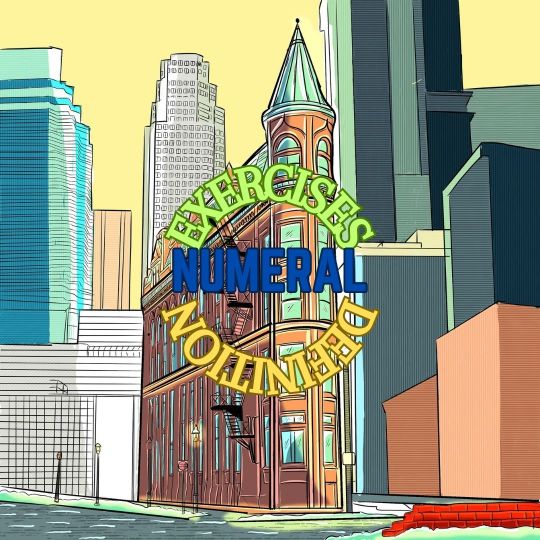
NUMERAL DEFINITION AND EXERCISES
In English grammar, numerals function as a part of speech to represent numbers, quantify nouns, and express numerical relationships.
There are two main types of numerals in English: cardinal numerals and ordinal numerals.
Cardinal Numerals: Cardinal numerals represent specific quantities or numbers.
They answer the question how many? and are used to count objects or denote a precise quantity.
Examples:
One, two, three, four, five, six, seven, eight, nine, ten
Eleven, twelve, thirteen, fourteen, fifteen, sixteen, seventeen, eighteen, nineteen
Twenty, thirty, forty, fifty, sixty, seventy, eighty, ninety
One hundred, two hundred, three hundred, etc.
One thousand, two thousand, three thousand, etc.
Ordinal Numerals: Ordinal numerals denote the order or rank of items in a sequence.
They answer the question in what order? and are used to indicate the position of something in a series.
Examples:
First, second, third, fourth, fifth, sixth, seventh, eighth, ninth, tenth
Eleventh, twelfth, thirteenth, fourteenth, fifteenth, sixteenth, seventeenth, eighteenth, nineteenth
Twentieth, thirtieth, fortieth, fiftieth, sixtieth, seventieth, eightieth, ninetieth
Hundredth, thousandth, millionth, billionth, etc.
Numerals can function as determiners when they directly modify nouns, indicating the quantity or position of the noun.
For example:
Cardinal Numeral as Determiner: Three apples fell from the tree.
Ordinal Numeral as Determiner: The first prize goes to the winner.
Numerals can also function as adjectives when they modify nouns but do not directly specify quantity or order.
For example:
Cardinal Numeral as Adjective: She bought two pairs of shoes.
Ordinal Numeral as Adjective: He is in his third year of university.
Additionally, numerals can function as nouns themselves, particularly when referring to numbers as concepts or entities.
For example:
The number eight is considered lucky in some cultures.
She divided the class into groups of four.
Instructions:
Please, do the exercises without seeing the Answers.
If you are unable to find an answer, you can check the answers provided below after attempting all the blanks.
Exercise: Numerals
Instructions: Use the correct words for (numbers in brackets). Write ordinal or cardinal number forms into the gaps:
- My sister is in the ------------ grade (2).
- I have ------------ fingers (10) on my hands.
- There are ------------ days (7) in a week.
- We need ------------ eggs (6) to make pancakes.
- Today is the ------------ day (1) of the month.
- The puppy is the ------------ pet (1) in our family.
- I have ------------ brothers (2) and ------------ sisters (1).
- There are ------------ months (12) in a year.
- She won the race and got the ------------ prize (1).
- My birthday is on the ------------ of July (4).
Correct Answers:
- second
- ten
- seven
- six
- first
- first
- two, one
- twelve
- first
- fourth
Exercise: Numerals
Instructions: Write the numbers in words:
- 75
- 1000000
- 50
- 3
- 12
- 20
- 18
- 45
- 90
- 600
- 0.5
- 0.7
- 0.25
- 0.01
- 2.5
- 0
- 50%
- 25%
- 10%
- 100%
- 1/2
- 3/4
- 1/4
- 1/10
Correct Answers:
- Seventy-five
- One million
- Fifty
- Three
- Twelve
- Twenty
- Eighteen
- Forty-five
- Ninety
- Six hundred
- Zero point five
- Zero point seventy-five
- Zero point twenty-five
- Zero point zero one
- Two point five
- Zero
- Fifty percent
- Twenty-five percent
- Ten percent
- One hundred percent
- One half
- Three quarters
- One quarter
- One tenth
Exercise: Numerals
Instructions: Write the numerals in numbers:
- Seventy-two
- Ninety-nine
- One hundred twenty-five
- Six hundred thirty-seven
- Four thousand five hundred eighteen
- Seven thousand six hundred twenty-three
- Fifty-three thousand two hundred forty-nine
- One hundred thousand
- Six hundred seventy-five thousand three hundred twenty-four
- Eight million nine hundred seventy-six thousand five hundred twelve
- Two hundred fifty-three
- Three thousand seven hundred eighty-six
- Twelve thousand three hundred forty-nine
- One million two hundred fifty thousand
- Six billion seven hundred eighty-nine million four hundred fifty-six thousand two hundred thirty-one
Correct Answers:
- 72
- 99
- 125
- 637
- 4518
- 7623
- 53249
- 100000
- 675324
- 8976512
- 253
- 3786
- 12349
- 1250000
- 6789456231
Exercise: Write the Time in English
Instructions: Write the given Time in English:
- 9:15 AM
- 1:30 PM
- 6:45 AM
- 3:20 PM
- 10:00 AM
- 5:55 PM
- 12:10 PM
- 8:40 AM
- 4:15 PM
- 11:50 AM
Correct Answers:
- 9:15 - Fifteen minutes past nine
- 1:30 - Half past one
- 6:45 - Quarter to seven
- 3:20 - Twenty past three
- 10:00 - Ten o'clock
- 5:55 - Five minutes to six
- 12:10 - Ten past twelve
- 8:40 - Twenty to nine
- 4:15 - Quarter past four
- 11:50 - Ten minutes to twelve
Exercise: Numerals
Instructions: Write in words
- 500
- 3000
- 400000
- 10000000
- 100000000
- 200
- 1001
- 2005
- 1250
- 2006
- 100 students
- 1000 books
- 200000 people
Correct Answers:
- Five hundred
- Three thousand
- Four hundred thousand
- Ten million
- One hundred million
- Two hundred
- One thousand and one
- Two thousand and five
- One thousand two hundred fifty
- Two thousand and six
- One hundred students
- One thousand books
- Two hundred thousand people
Exercise: Numerals in Sums
Instructions: Write the following Sums in words:
- 25 + 13
- 42 + 57
- 100 + 25
- 76 + 89
- 345 + 210
- 500 + 600
- 1234 + 5678
- 999 + 111
- 8765 + 4321
- 9876 + 5432
Correct Answers:
- Twenty-five plus thirteen
- Forty-two plus fifty-seven
- One hundred plus twenty-five
- Seventy-six plus eighty-nine
- Three hundred forty-five plus two hundred ten
- Five hundred plus six hundred
- One thousand two hundred thirty-four plus five thousand six hundred seventy-eight
- Nine hundred ninety-nine plus one hundred eleven
- Eight thousand seven hundred sixty-five plus four thousand three hundred twenty-one
- Nine thousand eight hundred seventy-six plus five thousand four hundred thirty-two
Exercise: Numerals in Subtractions
Instructions: Write the following subtractions in words:
- 50 - 25
- 100 - 67
- 150 - 89
- 500 - 238
- 1000 - 475
- 2500 - 1234
- 8765 - 4321
- 9876 - 5432
- 12345 - 6789
- 99999 - 88888
Correct Answers:
- Fifty minus twenty-five
- One hundred minus sixty-seven
- One hundred fifty minus eighty-nine
- Five hundred minus two hundred thirty-eight
- One thousand minus four hundred seventy-five
- Two thousand five hundred minus one thousand two hundred thirty-four
- Eight thousand seven hundred sixty-five minus four thousand three hundred twenty-one
- Nine thousand eight hundred seventy-six minus five thousand four hundred thirty-two
- Twelve thousand three hundred forty-five minus six thousand seven hundred eighty-nine
- Ninety-nine thousand nine hundred ninety-nine minus eighty-eight thousand eight hundred eighty-eight
Exercise: Numerals in Multiplications
Instructions: Write the following multiplications in words:
- 5 * 3
- 10 * 4
- 12 * 6
- 20 * 8
- 25 * 5
- 50 * 7
- 100 * 9
- 123 * 4
- 500 * 2
- 1000 * 3
Correct Answers:
- Five times three
- Ten times four
- Twelve times six
- Twenty times eight
- Twenty-five times five
- Fifty times seven
- One hundred times nine
- One hundred twenty-three times four
- Five hundred times two
- One thousand times three
Exercise: Numerals in Divisions
Instructions: Write the following divisions in words:
- 15 ÷ 3
- 20 ÷ 4
- 36 ÷ 6
- 45 ÷ 9
- 64 ÷ 8
- 81 ÷ 9
- 100 ÷ 5
- 200 ÷ 10
- 500 ÷ 25
- 1000 ÷ 50
Correct Answers:
- Fifteen divided by three
- Twenty divided by four
- Thirty-six divided by six
- Forty-five divided by nine
- Sixty-four divided by eight
- Eighty-one divided by nine
- One hundred divided by five
- Two hundred divided by ten
- Five hundred divided by twenty-five
- One thousand divided by fifty
Exercise: Writing Monetary Amounts
Instructions: Write the following monetary amounts in words:
- £5
- 10 shillings
- 26 pence
- $1
- £20
- 15 shillings
- 50 pence
- $5
- £100
- 5 shillings
Correct Answers:
- Five pounds
- Ten shillings
- Twenty-six pence
- One dollar
- Twenty pounds
- Fifteen shillings
- Fifty pence
- Five dollars
- One hundred pounds
- Five shillings
Exercise: Numerals in Phone Numbers
Instructions: Write Telephone Numbers in digits:
Telephone Numbers:
- 555-1234
- 867-5309
- 123-456-7890
- 800-555-1212
- 202-333-4567
- 555-6767-890
- 777-222-1010
- 123-456-7878
Correct Answers:
- Five five five, dash, one two three four
- Eight six seven, dash, five three zero nine
- One two three, dash, four five six, dash, seven eight nine zero
- Eight hundred, dash, five five five, dash, one two one two
- Two zero two, dash, three three three, dash, four five six seven
- Five five five, dash, six seven six seven, dash, eight nine zero
- Seven seven seven, dash, two two two, dash, one zero one zero
- One two three, dash, four five six, dash, seven eight seven eight
Exercise: Numerals
Instructions: Write the appropriate numerals for chapters of books, the numbers of buses, houses, taxis, and the sizes of clothes and shoes in words:
- Open page 10, please.
- He lives in apartment 18.
- I usually take tram No. 5.
- The meeting starts at 9 o'clock.
- There are 20 students in the classroom.
- She has 3 cats and 2 dogs.
- We need to buy 10 kilograms of rice.
- The marathon is 26.2 miles long.
- The speed limit is 55 miles per hour.
- He scored 15 points in the game.
Correct Answers:
- Open page ten, please.
- He lives in apartment eighteen.
- I usually take tram Number five.
- The meeting starts at nine o'clock.
- There are twenty students in the classroom.
- She has three cats and two dogs.
- We need to buy ten kilograms of rice.
- The marathon is twenty-six point two miles long.
- The speed limit is fifty-five miles per hour.
- He scored fifteen points in the game.
Read the full article
#age#amounts#books#buses#cardinal#century#chapter#chronological#dates#decades#first#howmany?#inwhatorder#millennia#monetary#numbers#numbersof#numerals#numerical#ofclothes#one#ordinal#percent#phone#quantity#ranges#second#seventy-two#shoes#sizes
2 notes
·
View notes